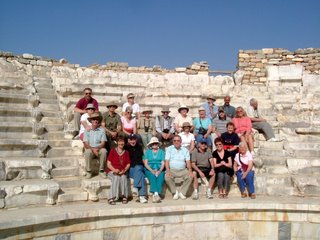Ephesus' history covers Greek Culture & Religion (Artemis - Diana, of the Ephesians), Commerce (Ephesus was a major commerce centre and it used to have its own harbour now some distance from the archeological site), Roman rule, early development of the Christian Church (nearby is the sanctuary where Mary, the mother of Jesus, was believed to have lived with her adopted son St John). Ephesus features prominently in the New Testament where quite a number of historical events are recorded. As well as, St Paul wrote a letter to the Christians in Ephesus and this has an important place in the New Testament. Historians believe that earliest settlement can be traced back as early as 13th century BC. What we visited today dated back mostly to the early AD period, and therefore predominantly covered the Roman period.
So, where to begin? A map of the archeological site is not a bad place to start:
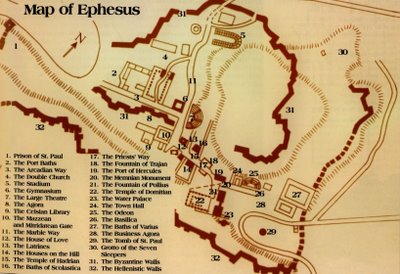
Our journey begins at the Basilica, constructed under Emperor Augustus, where commercial and financial transactions took place:

This also took us past the smaller of the theatres called the Odeon and led us past the monument of Memmius:

The next view gives us a first glimpse of the Celsian Library, and beyond in the distance where the Ephesus harbour would have been:

This stretch of road took us past the Trajan Fountain, dedicated to the Emperor Trajan back in about 102-114 AD :
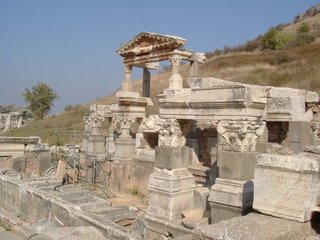
The following photo is of the Temple of Hadrian built in his honour.
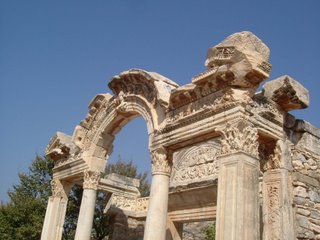
It features among other things, the story of Androklos - the town planner, and my eye especially caught the following detailed relief:
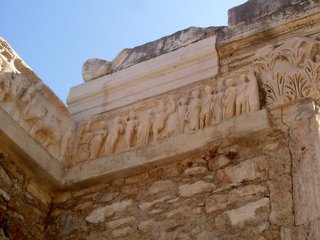
The Library in Ephesus dominates the skyline.
 It really is an impressive building with on its right, the Gate of Mazaeus & Mitridates that leads to the massive open air theatre:
It really is an impressive building with on its right, the Gate of Mazaeus & Mitridates that leads to the massive open air theatre:

Carol always was a great scholar and to stand in this ancient place of wisdom was pretty special. Particularly so, because she stood in the company of one of the four statues depicting Virtue, Wisdom, Fate & Genius. In this case, she identified with Sophia personifying Wisdom. (how appropriate!!)

On our way to the Great Theatre, we came across this mark on the road. What is it? One may well ask because it is a direction marker to.........yes, the Ephesus Brothel - one of the more important establishments of the city. Perhaps even the most profitable!

Finally the theatre!
 Was this really the place where there was such an uproar in about 50 AD by the Ephesian Guilds affirming that "Great is Diana of the Ephesians". Not so much because they wanted to protect her reputation, but more for the financial gain she gave to the traders in Ephesus. Carol once again gave voice to the apparent delight of another group of tourists who shouted for an encore. Ah, she is a great lady, this one!
Was this really the place where there was such an uproar in about 50 AD by the Ephesian Guilds affirming that "Great is Diana of the Ephesians". Not so much because they wanted to protect her reputation, but more for the financial gain she gave to the traders in Ephesus. Carol once again gave voice to the apparent delight of another group of tourists who shouted for an encore. Ah, she is a great lady, this one!
There was a sad omission on our tour. We did not see the site of the Temple of the Great Artemis. Sadly, all that remains of this marvelous temple - regarded as one of the seven wonders of the world in its day, is one column and a number of stumps. We have to be content with the model we saw in the Museum at Ephesus, which is well worth seeing. What a great building it must have been in its heyday!:

The following is a statue of Artemis and dates back to 1st Century BC. Wow! The cluster of breasts certainly tells you something about the original creators of the statue. Freud would have had a field day!

To conclude Ephesus, a contrast - First a pic of Emperor Aulrelius (161-180AD), recorded as the last of the 'Good Emperors':

Now a pic of present day Ephesus marketing 'Genuine Fake Watches'! The difference? One is original and real, the other fake and probably a dud!

We stay with ancient history for one more day. Pergamum is situated on top of a mountain and has amazing views over the countryside. It also has an amazingly small carpark where busses have great difficulty getting in and out - and we were there during the off season! Pergamum had apparently the second best library in the ancient world. It is also the place that developed parchment (pergaminus, the Latin name for parchment, comes from this city). The latter bit we found out since coming back home. The Christian Church in Pergamum is also one of the seven churches that received a special message as recorded in the book of Revelation.
Looking from Asclepius, one gets a little idea of the steepness and altitude of Pergamum:
 The theatre cut out into the mountain is clearly visible in this photo.
The theatre cut out into the mountain is clearly visible in this photo.
The next photo was taken just above the theatre and shows part of Pergamum with the drop down the mountain also evident:

The sheer height of this structure is best illustrated by Carol's little figure pointing way up:

This photograph of the theatre shows both the steepness and the views from this acropolis:

TROY, a place that we have heard so much about. Well....at least we have heard about the Trojan Horse:

And what else? We were not aware that there were nine distinct periods of occupation in Troy, all built one on top of the other.
 How far did this go back? The best I can do is 'legendary times'. If anyone can improve on that, please feel free to leave a comment or two on the blog.
How far did this go back? The best I can do is 'legendary times'. If anyone can improve on that, please feel free to leave a comment or two on the blog.
The hotel we stayed in that night had other art work to cheer us up. This picture was above our bed and shows a couple most content. Just let me assure you that we just slept and slept very well!

From experiencing thousands of years of history, our second last day in Turkey was spent experiencing more recent history as we proceeded to Gallipolli, the site of extensive fighting in the Great War of 1914-18.
This bit is a personal reflection which we are happy to share. Neither Carol nor I had any emotional anticipation about Gallipolli where Australians and New Zealanders fought against all the odds. Carol had no relatives associated with the fighting here. As for me, my background is Dutch and consequently also did not have a direct connection. As such, we went to Gallipolli like we would any other place. Interested, yes! Emotional, no! But what a surprise awaited us both. We went our separate ways and experienced intense emotional reactions when walked along ANZAC Cove and among the graves of our 'diggers'.

It made me very conscious of how special this place really was for Australians. I felt the strong sense that here were the foundation pillars of our nation - the defining moment of our history as an independent nation. It did something very special. Carol experienced similar feelings, quite independently.
As we wandered among the graves of the first cemetery (and there are several cemeteries) ......

.....the sun made its first appearance over 'The Ridge' that was to be captured by the 'British Empire' forces back in 1915:

Up the hill, we visited Lone Pine Cemetery. We can do no better than to just leave you with two images:


It was also an emotional moment when we read a special message from President Ataturk. Here is the picture of that tribute. Please click on it and read what it says, for it is very moving:

After that, it was good to also visit the Memorial for the Turkish soldiers:

The people at the top of the photo were reading a plaque that was pretty special. Here it is:

And this is the commanding view the Turkish soldiers would have had over what we now know as ANZAC Cove:
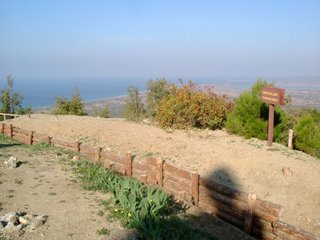

Finally, back in Instanbul. It has been a great journey and it was rather sad that the tour finished on a bit of a low note with pick-pocket activity and rather unkind weather. We finished by visiting the Blue Mosque in Instanbul:

As well, a visit to Haghia Sophia was interesting but at the same time disappointing. Perhaps, we were all a bit toured out by now. Certainly Carol and I had eight very interesting weeks on the road. So let us conclude with some views at Haghia Sophia, including these shots of the inside that show an intriguing mixture of early Christianity and Islam:



A visit to the Topkapi Palace, the home of Turkish Sultans for four hundred years, was of particular interest. Among a variety of treasures that included weapons & porcelain exhibits was a collection of items from the prophets that certainly had us intrigued. These were housed in this building:
 Busses squeezed through this gate to return us to our hotel:
Busses squeezed through this gate to return us to our hotel: A final look at Instanbul.....
A final look at Instanbul.....
.....and it's goodbye to Turkey -
 Up, up and away..........
Up, up and away.......... 
And finally after 24 hours flying and at airports, including seeing our lovely granddaughter Amy at Melbourne airport in our way to....our HOME on the beach!





























